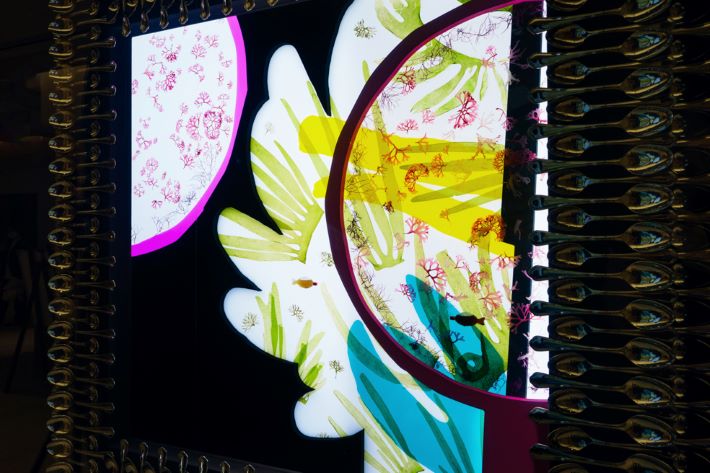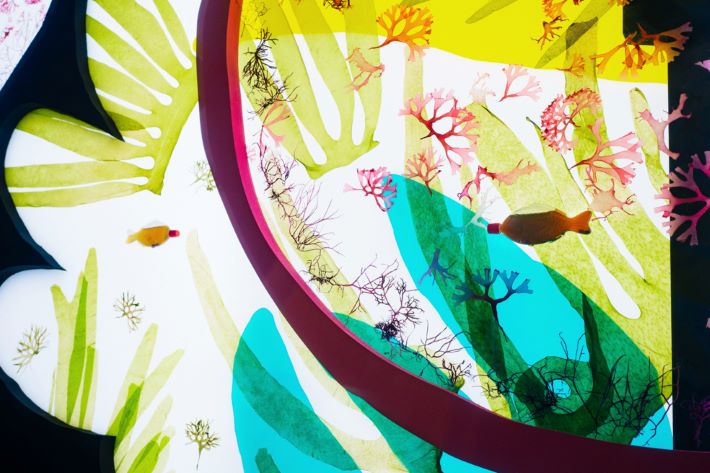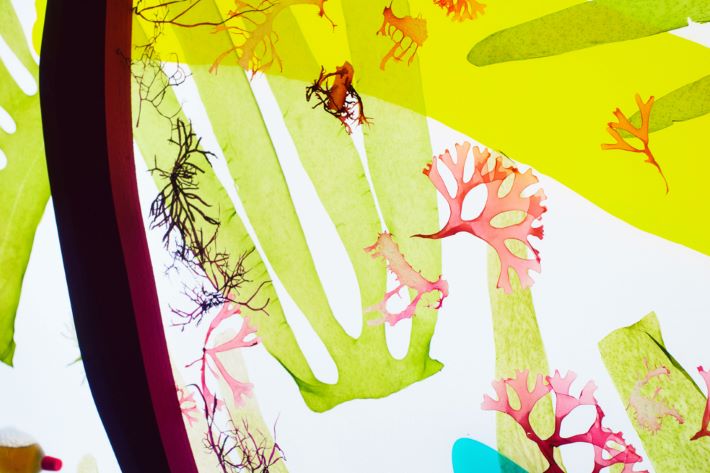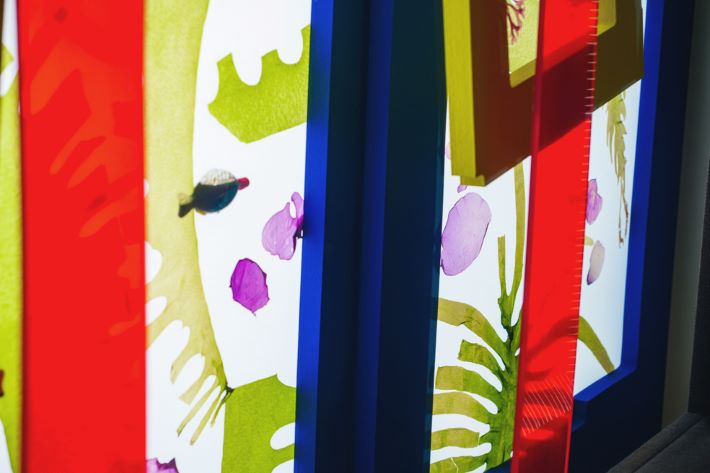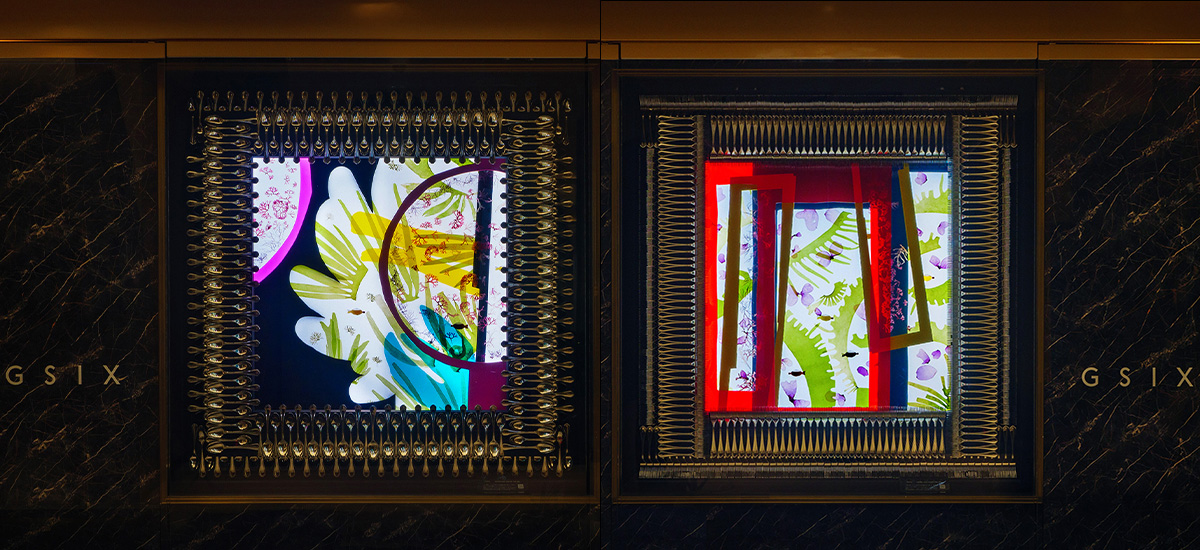
Summer「SWING JAZZ UNDER THE SEA」
Show Window
日本人にとっては身近な食材である海藻が近年「未来食」として注目を浴びています。
食物繊維やミネラル、ビタミン、タンパク質、うまみ、抗酸化物質を多く含み低カロリーである海藻は、健康や美容志向の人々に”スーパーフード”と呼ばれています。これまで海藻を食べる習慣の無かった欧米のオーガニック・スーパーでも扱われるようになり、この20年余りで世界の海藻の消費量は約3倍に増えています。
肥料や農薬を使用せずに一年中収穫でき手頃な値段で手に入る海藻は、WWF UKが食品会社Knorと協力して選出した「Future Foods 50」にランクインするなど、増え続ける世界の人口に対し、将来的な食料安全保障への貢献も期待されています。ベーコンの風味をつけた海藻など、フードテクノロジーにより、代替肉の原料とする研究も始まっています。
海洋の植物である海藻は、陸上の植物と同様に光合成によって二酸化炭素(CO2)を吸収します。国連環境計画(UNEP)の報告書で、陸上の森などで取り込まれる炭素、「グリーンカーボン」に対し、海藻など海洋生態系に取り込まれた炭素を「ブルーカーボン」と命名し、地球温暖化に歯止めをかけるため「ブルーカーボン」にも期待が集まっています。海中酸素の生産の約半分を担い、海洋生態系を保全・再生すると言われる海藻は、SDGs持続可能な開発目標の14番目、「海の豊かさを守ろう」の達成にも、大きな役割を果しています。
歴史的にも長く多様な海藻の食文化を持つ日本の各地から、食材として流通している海藻を集めて押し葉にしました。彼らが波に身を任せてスウィングしていた海中の姿を思わせる流線型のフォルムと、光を受けて透ける色に美を感じます。海藻とともにある豊かな未来を、このウィンドウから思い描いて下さい。
アートディレクター
佐藤寧子
Seaweed, which Japanese people routinely enjoy as a food, has recently drawn attention as a food of the future.
Called a superfood by the health- and beauty-conscious, seaweed is low in calories but packed with fiber, minerals, vitamins, protein, antioxidants, and umami flavor. Although not a traditional food item in these regions, it can now be found in organic groceries in Europe and North America. In just over 20 years, the world’s seaweed consumption has nearly tripled.
Seaweed is inexpensive, requires no fertilizer or agricultural chemicals, and can be harvested year-round. It was named among the Future 50 Foods, a list compiled by the WWF UK in collaboration with Knorr, a food products brand. As the world’s population continues to grow, seaweed is expected to play a growing role in food security. Research has also begun on finding ways to use it as an alternative to meat—to produce, for example, seaweed that tastes like bacon.
As an ocean plant, seaweed absorbs carbon dioxide through photosynthesis, just as plants do on land. In a report issued by the United Nations Environment Programme (UNEP), whereas carbon dioxide absorbed by forests on land is called “green carbon,” carbon dioxide absorbed in marine ecosystems, e.g., by seaweed, is referred to as “blue carbon.” Hopes are high that blue carbon will help put the brakes on global warming. Seaweed, which accounts for nearly half the oxygen production in the ocean, has been called both a guardian of and restorative agent for marine ecosystems. It plays a key role in Sustainable Development Goal No. 14, “Life Below Water.”
Seaweed harvested as food in various regions in Japan, which have long histories of diverse seaweed cultures, is gathered and formed into pressed leaves. The flowing forms are reminiscent of how seaweed lives and grows at the will of the waves, how it swings and sways. Its translucent color in light has a striking beauty. We hope this window will inspire you to begin thinking about a prosperous future that involves seaweed.
Yasuko Sato
フロア: B2F
開催場所: ショーウィンドウ
開催期間: 2024.06.07- 2024.09.06
終了しました
2024.06.10 UP



